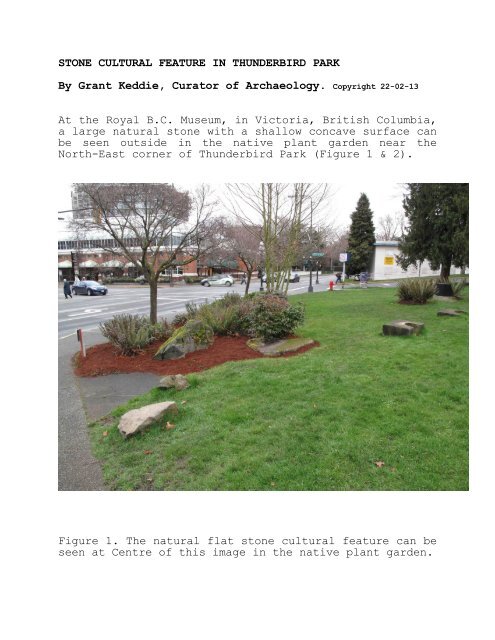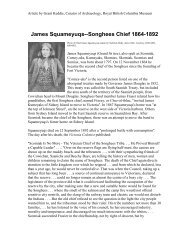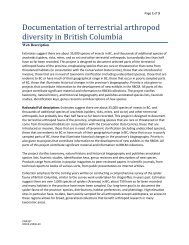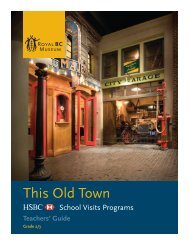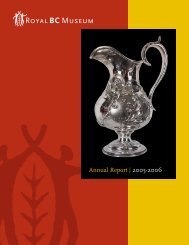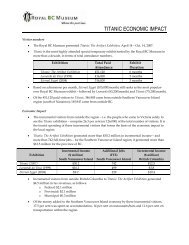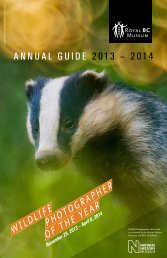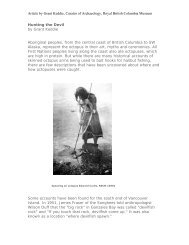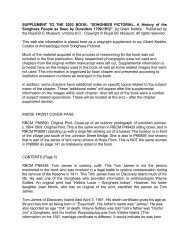Grant Keddie - Notes Oct - Royal BC Museum
Grant Keddie - Notes Oct - Royal BC Museum
Grant Keddie - Notes Oct - Royal BC Museum
Create successful ePaper yourself
Turn your PDF publications into a flip-book with our unique Google optimized e-Paper software.
STONE CULTURAL FEATURE IN THUNDERBIRD PARKBy <strong>Grant</strong> <strong>Keddie</strong>, Curator of Archaeology. Copyright 22-02-13At the <strong>Royal</strong> B.C. <strong>Museum</strong>, in Victoria, British Columbia,a large natural stone with a shallow concave surface canbe seen outside in the native plant garden near theNorth-East corner of Thunderbird Park (Figure 1 & 2).Figure 1. The natural flat stone cultural feature can beseen at Centre of this image in the native plant garden.
Figure 3.During light rainfalls, unique patterns are formed on thesurface of the collected water.This large rock was moved from its former location, nearthe <strong>Museum</strong>’s old First Nations carving shed and placedin its present location in 2001.The Written RecordThis item is recorded in the Annual Report of theProvincial <strong>Museum</strong> for 1940, as “Large Stone mixing bowlfrom Tranquille” and donated by “P. Walker, Victoria”.
A photograph of it in more pristine condition is in ourAnthropology photo collection as PN6919 (Figure 3). ThePN6919 print has written on it “#15572 Archives InteriorSalish Ceremonial bowl of granite”. The negative, whichappeared to have been made from a photo in a scrapbook,with text underneath, includes part of the text: “Indianmixing bowl made out of granite rock 10m, S.W. Kamloops.(form of oyster shell) 125 years since Indians used it.Weathering shows .”Figure 4.Photograph showing the Cultural Rock in its originallocation. R<strong>BC</strong>M PN6919.Figure 4, shows the rock in what might be its originalposition, with a propped-up barbed-wire fence runningacross it. I suspect P. Walker was a government officialwho arranged to bring the rock to Victoria.There is an article in the Victoria Colonist on April14, 1935 (page 6), about this rock titled: “IndianMixing Bowl Shaped Like a Lake”, written by J. Scruton.It describes the rock as being “found within one mile of
the Iron Mask Mine, southwest of Kamloops”. The articleis a mixture of fantasy with some information that maybe based on fact or invented recent legend. It issuggested that First Nations groups “periodicallyassembled around this bowl and settled their politicaldifferences with bone-point spears and tomahawks”. Thearticle suggests that the rock was deliberately carvedin the shape of an oyster and that it also is the sameshape of the small alkali lake that it was found nextto. The rock is, in fact, a natural rock that shows noevidence of being shaped other than more recent bangsfrom it being moved around. James Bunyan Munro (thenDeputy Minister of Agriculture) became interested in thestone when he saw it filled with water after arainstorm: “His investigations have revealed somethingof its history and secured for it a new location”. Therock had “just been transported” to the TranquilleSanatorium near the time of the article.The article states that before the rock was removed it“stood for around 125 years where the Indians positionedit, where it figured in intertribal conferences andsquabbles, and was used for the pounding up of nativegrains, berries and pemmican”. The article claims “thebowl is a miniature reproduction of a small lake withina short distance of where the stone bowl stood so long”.A picture of the lake is shown with a picture of therock.An Article in The Daily Colonist newspaper of Victoriaon August 13, 1935 entitled “Indian Relic At Tranquille.Massive Boulder, Hollowed Into Three Basins, BelievedUsed Long Ago” and A Vancouver Sun article of August 16,1935 (p.2) titled “Huge Indian Relic” - which repeatsthe same information - records the rocks arrival at theTranquille Sanitarium.“On the lawn at Tranquille Sanitarium this week stands agrey granite stone weighting a ton and a half, believedto be one of the largest preserved relics of Indiancivilization in British Columbia.Discovered by John Bunyan Munro, Deputy Minister ofAgriculture, some years ago, the stone was moved at hisrequest to Tranquille from an unnamed alkali Lake, sevenmiles southwest of Kamloops.
The stone is hollowed into three compartments, includinga large basin, believed to have been used forevaporating water to get native salts of the area usedin fur preservation; and smaller basins in whichpemmican may have been pounded.Weighing 3600 pounds, the stone was too heavy to move tothe B.C. <strong>Museum</strong> except at considerable cost. Mr. Munrosaid.”What Can We Say About This Cultural Feature?The 1935, Colonist article indicates that the originallocation of the large rock was within a mile of IronMask Mine. Iron Mask Mine is located at UTM 10 5614350681220 and Latitude 50 39 17N and Longitude 120 26 11 W.An image of the lake shows its general shape to be ovalwith a small protrusion into the Lake at one end andhill on both sides in the background. This would makethe most likely candidate for the location to be thesmall oval lake along the road located on the map inLot 879 to the north-east of Ironmask Hill.This location is within the Borden Unit area EdRc.(Archaeological sites are recorded according to asystem of latitude and longitude developed by the lateDr. Charles Borden of the University of BritishColumbia). The most appropriate site number to give thelarge rock at this time would be EdRc-Y (The “Y” refersto the general locality and not to a specific sitelocation). An on site comparison with the newspaperimage of the lake and those in the general area will benecessary before a definite conclusion can be made asto the original location of the cultural rock.We do know that First Nations of the Interior consideredsome of the isolated or unusually shaped boulders to betransformed people or animals of an earlier time. Thepeople of this early world had animal characteristics.They were gifted in magic, and their children reachedmaturity in a few months. This time period ended with thecoming of the transformer beings who changed some peopleinto real animals and others, as well as animals, intorocks. Many of these boulders were connected to
activities of the supernatural Coyote or a person calledthe Transformer. What is fact and what is fictionregarding the written history of this boulder remainsuncertain.


